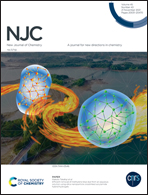Insight into the adsorption of Cr(vi) on functionalized carboxymethyl cellulose-based sponge via experimental and theoretical calculations†
Abstract
In the present study, a functionalized carboxymethyl cellulose-based adsorbent (PEI–PAM–CMC) was prepared via linking polyethyleneimine and polyacrylamide with carboxymethyl cellulose by epichlorohydrin. It possessed a sponge-like structure with a large number of micron-sized pores, which facilitated the mass transfer of Cr(VI). Under neutral conditions, Cr(VI) can be efficiently removed by the protonated PEI–PAM–CMC. The residual levels in the effluent were below 0.5 and 0.05 mg L−1 for 10 and 1 mg L−1 of Cr(VI), respectively. The adsorption data fitted well with the pseudo-second order kinetic model and Langmuir isotherm. Common ions including Cl−, H2PO4−, NO3−, K+, Na+, Ca2+, Mg2+ and Cr3+ had neglectable influence for Cr(VI) adsorption on the PEI–PAM–CMC except SO42−. Meanwhile, PEI–PAM–CMC showed good regeneration and reusability with a 7.5% decrease in the removal rate after ten adsorption/desorption cycles. XPS analysis and DFT calculation revealed that Cr(VI) uptake by the PEI–PAM–CMC was involved in electrostatic attraction and chemical binding. Electrostatics and induction were the main weak interaction between Cr(VI) and the adsorbent, and the major chemical adsorption sites were mainly distributed in the nitrogen groups. This research not only developed an efficient material for Cr(VI) removal but also provided a promising insight into an adsorption mechanism study.



 Please wait while we load your content...
Please wait while we load your content...